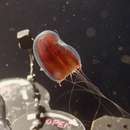en
names in breadcrumbs


Die Pandeidae sind eine marine Familie der Hydrozoen (Hydrozoa). Die Familie umfasst derzeit etwa 75 Arten. Die Gattung Hydrichthys enthält auch Arten, die auf Köpfen von Fischen parasitieren.
Die Hydroidpolypen sind gewöhnlich stolonal und selten verzweigt. Ein Perisarc kann bis zu einem gewissen Grad entwickelt sein oder auch fehlen. Gelegentlich bildet es eine Pseudohydrothek. Die Tentakeln der Hydranthen sind filiform, die gewöhnlich in einem Kranz, ausnahmsweise auch in zwei oder mehr Kränzen angeordnet sind. Sie können aber auch gleichmäßig verteilt sein oder auch fehlen. Die Vermehrung erfolgt ungeschlechtlich durch Knospung und geschlechtlich hauptsächlich über Medusen. Der Schirm ist hoch-glockenförmig mit oder ohne apikalem Fortsatz. Das Manubrium ist annähernd quadratisch und gewöhnlich relativ groß. Es kann ein Gastralstiel vorhanden sein. Das Manubrium besitzt vier einfache, gezähnelte oder komplex verfaltete Mundlippen. Es sind vier, ausnahmsweise auch acht radiale Kanäle vorhanden, die oft breit und bandartig ausgebildet sind. Mesenterien sind vorhanden oder können auch fehlen. Die Gonaden sitzen am Manubrium in interradialer Position, manchmal erstrecken sie sich auch entlang der radialen Kanäle. Sie können sich aber auch komplett in einer perradialen Position befinden. Sie können glatt oder komplex verfaltet sein. Es sind zwei oder mehr hohle Randtentakeln vorhanden. Die Knollen sind meist konisch oder gelängt, mit oder ohne rudimentäre Tentakeln. Ocelli können vorhanden sein, aber auch fehlen. Das Cnidom besteht aus mikrobasischen Eurytelen.
Die Vertreter der Familie sind weltweit in allen Meeren verbreitet.
Das Hydrozoa Directory stellt 23 Gattungen zur Familie. Zwei weitere Gattungen wurden bereits von Boero et al. (1991) zur Familie gestellt.
Die Pandeidae sind eine marine Familie der Hydrozoen (Hydrozoa). Die Familie umfasst derzeit etwa 75 Arten. Die Gattung Hydrichthys enthält auch Arten, die auf Köpfen von Fischen parasitieren.
Pandeidae is a family of hydroids in the class Hydrozoa. Like other jellyfish there is usually a mature medusa form which is pelagic and reproduces sexually and a hydroid or polyp form which is often benthic and reproduces asexually by budding.[2]
Members of this family have bell-shaped medusae with a four-part manubrium or sub-umbrella, a mouth with four plain or pleated lips and four, often broad, radial canals. The gonads are smooth or folded and positioned on the walls of the manubrium and sometimes extend onto the radial canals. There are fine, hollow tentacles along the margin of the bell, mostly growing from small carrot-shaped bulbs. The hydroids have threadlike tentacles.[3]
The World Register of Marine Species recognises the following genera:[1]
Pandeidae is a family of hydroids in the class Hydrozoa. Like other jellyfish there is usually a mature medusa form which is pelagic and reproduces sexually and a hydroid or polyp form which is often benthic and reproduces asexually by budding.
Les Pandeidae forment une famille de cnidaires hydrozoaires de l'ordre des Anthoathecatae.
Les hydroïdes sont généralement stolonaux, rarement ramifiés ; l'hydranthe a des tentacules filiformes, normalement dans une spire, exceptionnellement dans deux ou plusieurs spires, voire dispersé, ou absent. Le perisarc est développé à un degré variable, formant parfois une pseudohydrotheque ou complètement absent. La reproduction se fait principalement par méduse libre, sauf dans quelques genres dérivés, d'affinité douteuse. L'ombrelle de la méduse est haute et en forme de cloche, avec ou sans projection apicale. Le manubrium est quadratique, généralement grand, avec ou sans pédoncule gastrique. On y distingue quatre lèvres orales, simples, crénulées, ou pliées de manière complexe. On note quatre (ou exceptionnellement huit) canaux radiaux, souvent larges et en forme de ruban, rarement centripètes, avec ou sans mesenteries. Les gonades ont une surface lisse ou très plissée, sur les parois du manubrium en position adradiale ou interradiale, se prolongeant parfois le long de canaux radiaux, ou complètement perradiaux. L'animal est pourvu de deux (ou plus) tentacules marginaux creux ; les bulbes sont généralement effilés, allongés et coniques, avec ou sans tentacules rudimentaires (tentaculae) ou verrues marginales ; avec ou sans ocelle abaxiale[2].
Selon World Register of Marine Species (7 juin 2016)[2] :
Les Pandeidae forment une famille de cnidaires hydrozoaires de l'ordre des Anthoathecatae.
Pandeidae is een familie van neteldieren uit de klasse van de Hydrozoa (hydroïdpoliepen).
Pandeidae is een familie van neteldieren uit de klasse van de Hydrozoa (hydroïdpoliepen).